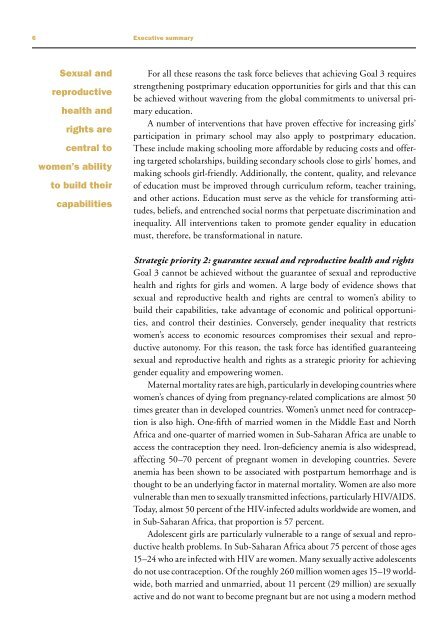Taking action: achieving gender equality and empowering women
Taking action: achieving gender equality and empowering women
Taking action: achieving gender equality and empowering women
Create successful ePaper yourself
Turn your PDF publications into a flip-book with our unique Google optimized e-Paper software.
6 Executive summary<br />
Sexual <strong>and</strong><br />
reproductive<br />
health <strong>and</strong><br />
rights are<br />
central to<br />
<strong>women</strong>’s ability<br />
to build their<br />
capabilities<br />
For all these reasons the task force believes that <strong>achieving</strong> Goal 3 requires<br />
strengthening postprimary education opportunities for girls <strong>and</strong> that this can<br />
be achieved without wavering from the global commitments to universal primary<br />
education.<br />
A number of interventions that have proven effective for increasing girls’<br />
participation in primary school may also apply to postprimary education.<br />
These include making schooling more affordable by reducing costs <strong>and</strong> offering<br />
targeted scholarships, building secondary schools close to girls’ homes, <strong>and</strong><br />
making schools girl-friendly. Additionally, the content, quality, <strong>and</strong> relevance<br />
of education must be improved through curriculum reform, teacher training,<br />
<strong>and</strong> other <strong>action</strong>s. Education must serve as the vehicle for transforming attitudes,<br />
beliefs, <strong>and</strong> entrenched social norms that perpetuate discrimination <strong>and</strong><br />
in<strong>equality</strong>. All interventions taken to promote <strong>gender</strong> <strong>equality</strong> in education<br />
must, therefore, be transformational in nature.<br />
Strategic priority 2: guarantee sexual <strong>and</strong> reproductive health <strong>and</strong> rights<br />
Goal 3 cannot be achieved without the guarantee of sexual <strong>and</strong> reproductive<br />
health <strong>and</strong> rights for girls <strong>and</strong> <strong>women</strong>. A large body of evidence shows that<br />
sexual <strong>and</strong> reproductive health <strong>and</strong> rights are central to <strong>women</strong>’s ability to<br />
build their capabilities, take advantage of economic <strong>and</strong> political opportunities,<br />
<strong>and</strong> control their destinies. Conversely, <strong>gender</strong> in<strong>equality</strong> that restricts<br />
<strong>women</strong>’s access to economic resources compromises their sexual <strong>and</strong> reproductive<br />
autonomy. For this reason, the task force has identified guaranteeing<br />
sexual <strong>and</strong> reproductive health <strong>and</strong> rights as a strategic priority for <strong>achieving</strong><br />
<strong>gender</strong> <strong>equality</strong> <strong>and</strong> <strong>empowering</strong> <strong>women</strong>.<br />
Maternal mortality rates are high, particularly in developing countries where<br />
<strong>women</strong>’s chances of dying from pregnancy-related complications are almost 50<br />
times greater than in developed countries. Women’s unmet need for contraception<br />
is also high. One-fifth of married <strong>women</strong> in the Middle East <strong>and</strong> North<br />
Africa <strong>and</strong> one-quarter of married <strong>women</strong> in Sub-Saharan Africa are unable to<br />
access the contraception they need. Iron-deficiency anemia is also widespread,<br />
affecting 50–70 percent of pregnant <strong>women</strong> in developing countries. Severe<br />
anemia has been shown to be associated with postpartum hemorrhage <strong>and</strong> is<br />
thought to be an underlying factor in maternal mortality. Women are also more<br />
vulnerable than men to sexually transmitted infections, particularly HIV/AIDS.<br />
Today, almost 50 percent of the HIV-infected adults worldwide are <strong>women</strong>, <strong>and</strong><br />
in Sub-Saharan Africa, that proportion is 57 percent.<br />
Adolescent girls are particularly vulnerable to a range of sexual <strong>and</strong> reproductive<br />
health problems. In Sub-Saharan Africa about 75 percent of those ages<br />
15–24 who are infected with HIV are <strong>women</strong>. Many sexually active adolescents<br />
do not use contraception. Of the roughly 260 million <strong>women</strong> ages 15–19 worldwide,<br />
both married <strong>and</strong> unmarried, about 11 percent (29 million) are sexually<br />
active <strong>and</strong> do not want to become pregnant but are not using a modern method

















